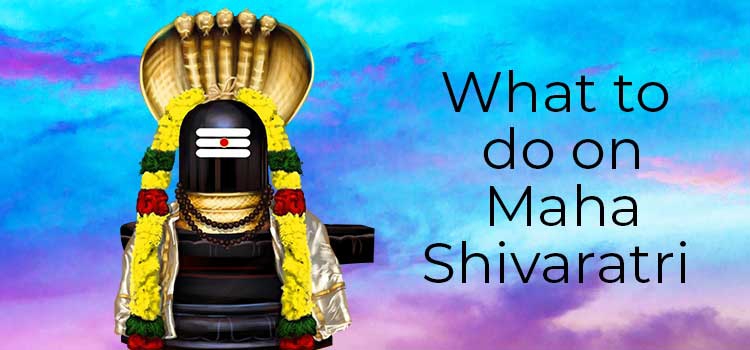What to do on Maha Shivaratri
What to do on Maha Shivaratri?
Maha Shivaratri is one of the most ancient and celebrated festivals in honor of Shiva. It falls on the 14th (Chaturdashi) day of the waning phase of the moon (Krishna Paksha) in the month of Phalguna (Falgun). This year it falls on Thursday, March 11, 2021.
Maha Shivaratri means 'The Great Night of Shiva.' Although Shivratri occurs on the 14th day of every lunar month, the Maha Shivaratri is believed to be of great significance. This day denotes the celebration of life and existence.
It is a day devoted to the worship of Lord Shiva, to honor and revere him. He is a very powerful God and one among the Holy Trinity with Brahma and Vishnu. He destroys, protects, and creates. The day involves prayer, meditation, and other spiritual practices that enhance the spiritual energy and reaches a pinnacle to experience the inner self's awakening. One can observe a fast on this auspicious day. It is a healthy manner of detoxifying the body and calming the mind. It helps in meditation.

Receive A Free Energized Rudraksha For Maha Shivaratri
On Maha Shivaratri, meditation is undertaken. People can meditate at night while keeping the all-night-long vigil. One can keep awake through the night and focus on spirituality. Chant the sacred mantra - 'Om Namah Shivaya.' 'Om' is the entirety of the universe. It is a sacred sound. It refers to the Atman (soul) and the Brahman - the Supreme spirit, the ultimate Truth, the Divine. The shape of 'Om' is unique. The upper curve denotes the unconscious mind, the lower curve signifies the waking state, and the middle curve denotes a dream state. The semi-circle at the top signifies illusion, and the dot, the absolute state. Chanting this mantra harmonizes the five elements of the universe and brings peace, love, and harmony.
Perform or attend the Maha Shivaratri Pooja. Offering worship and chanting the sacred mantras bring positivity to the environment and remove all negative energy. It calms the mind and helps one to meditate easily. The chants are powerful and cause energy vibrations that can impact our lives positively.
Offer worship to the Shiva Linga. You can make an offering of Bilva leaves that represent Rajas (aspect for being responsible), Tamas (an aspect that brings inertia), and Sattva (that brings peace, positivity, and creativity). When we surrender to the Divine in prayer, we attain freedom and peace.
Listen to stories of Shiva, the Shiva Purana, or chant the sacred mantras. One can sing songs and bhajans to revere Shiva. One can visit the Shiva temples at night as a full vigil through the night is kept in all temples. Prayers are offered, and one can participate in them. The Shiv Chalisa is recited.
Perform the Maha Shivaratri Pooja at home. Initiate the pooja at sunset and continue to do the pooja until sunrise. Although the fast is undertaken, Sattvic delicacies are prepared to be consumed after breaking the fast. One can offer milk products as Shiva is fond of them. Kheer or milk barfi can be made as an offering to the deity. While making the offering of milk, curd, and water, as part of the pooja ritual, offer them in a copper pot. Do not use bronze as it is associated with wine and is inappropriate.
While worshipping the Shiva Linga, please do not make a full Pradakshina (circumambulation). Go in a semi-circle and return to where you started from. At the end of the pooja, one can donate Prasad, food, clothing, and other essentials to the needy.
On Maha Shivaratri, the women offer prayers to the deity. Married women pray for their spouses' wellbeing and longevity, while unmarried women pray for a spouse like Shiva, known to be the ideal husband. Spiritual seekers worship Shiva as the Adi Guru as divine wisdom originates from him.
On the other hand, there are certain don'ts to be maintained during the main Shivaratri festival. Please refrain from wearing black as it is considered inauspicious. One can wear clothes in yellow, red, or pink. Refrain from consuming rice, pulses, and wheat. While fasting, it is advised to consume water, milk, and fruits.
Do not use Haldi (turmeric) in the pooja and, also, Tulsi leaves. According to Vedic tradition, one must not offer turmeric and vermilion to the Shiva Linga. Only ash can be offered, as Shiva is a recluse. Ketaki and Champaka flowers should not be offered to the deity.
Worshipping Shiva on this auspicious day brings blessings. Prayer, meditation, and fasting are some of the main aspects of Maha Shivaratri as they remove negative energy and purify the body and soul, increasing positive energy and enhancing inner strength and spiritual intent. Spiritual devotion combined with meditation can bestow the grace of Shiva and fulfill your prayers and wishes.



















